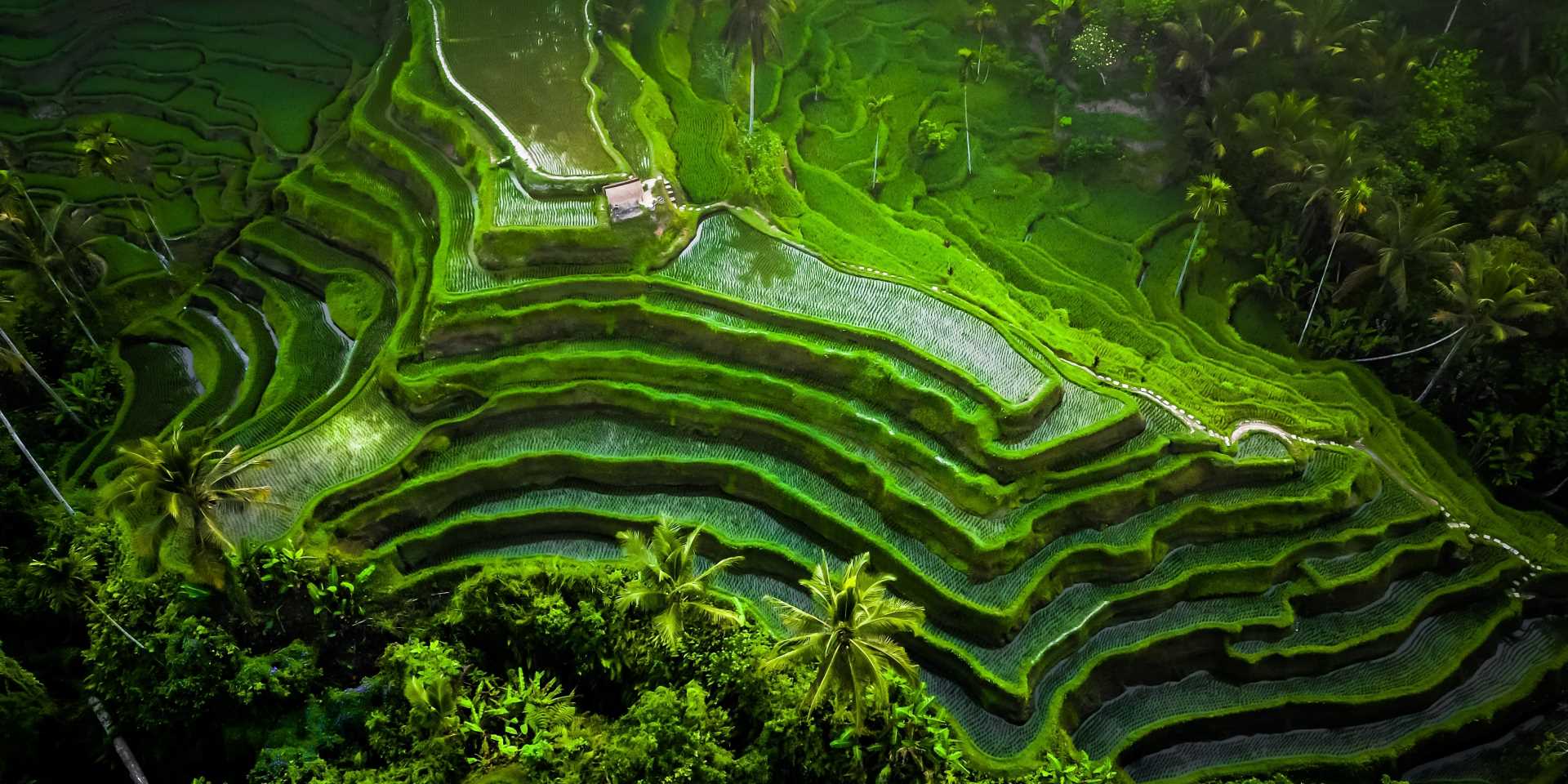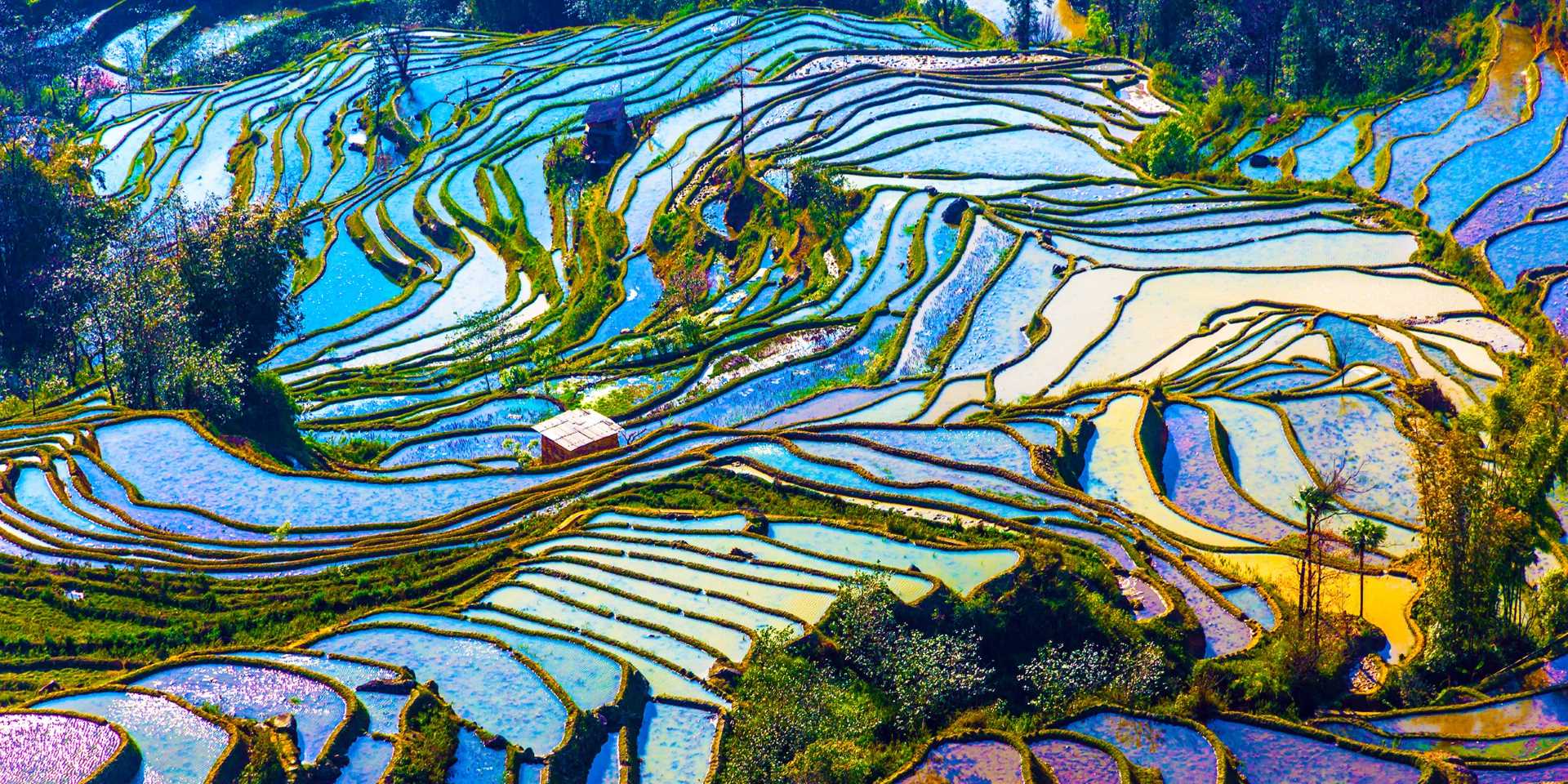
The Majestic Terraced Rice Fields of Asia
Imagine standing atop a verdant hill, gazing over an endless expanse of emerald green terraces cascading down the mountainside. The sight is breathtaking, as each step carved into the hillside tells a story of past generations. These terraced rice fields, found in places like Bali, Indonesia, and Banaue, Philippines, are marvels of agricultural engineering and living testament to the harmony between humans and nature. Join us to uncover the beauty, tradition, and significance of these iconic Asian landscapes.
Tegallalang Rice Terraces
Bali, Indonesia

Image via Rizky Ade Jonathan/shutterstock.
The Tegallalang Rice Terraces in Bali, Indonesia, are a testament to natural beauty and agricultural ingenuity. These lush green terraces, carved into the hills, cascade down gracefully, creating a mesmerizing stairway of rice paddies. Visitors are greeted by panoramic views of verdant fields punctuated by coconut trees and traditional Balinese huts. The terraces showcase the island's traditional subak irrigation system and offer a serene retreat for those seeking tranquillity amidst breathtaking landscapes. Tegallalang's timeless allure attracts tourists and photographers alike, capturing the essence of Bali's rich cultural and natural heritage.
Banaue Rice Terraces
Philippines

Image via RZL GatCo/shutterstock.
The Banaue Rice Terraces in the Philippines are often hailed as the "Eighth Wonder of the World." Carved into the Ifugao mountains over 2,000 years ago by ancestors of the indigenous people, these terraces showcase remarkable engineering and cultural heritage. They are a UNESCO World Heritage Site and provide stunning views and cultural experiences. Stretching like stairways to the sky, they reflect a sustainable farming system using ancient irrigation technology. The terraces are agricultural marvels and cultural icons, symbolizing harmony between humans and nature. Surrounded by mist-shrouded mountains, they offer breathtaking vistas that attract visitors seeking both natural beauty and insight into the Philippines' rich indigenous traditions.
Jatiluwih Rice Terraces
Bali, Indonesia

Image via Teerasak Chinnasot/shutterstock.
The Jatiluwih Rice Terraces in Bali, Indonesia, are a UNESCO Cultural Landscape, celebrated for their pristine beauty and agricultural significance. Located in the lush heartland of Bali, these terraces unfold like green carpets across the slopes of Mount Batukaru, showcasing intricate rice paddies irrigated by a traditional subak system. The landscape captivates with its verdant expanses and preserves Bali's centuries-old farming traditions. Visitors can wander along scenic pathways, taking in panoramic views of terraced fields interspersed with coconut palms and dense forests, making Jatiluwih a serene retreat steeped in cultural heritage and natural splendour.
Mu Cang Chai Rice Terraces
Vietnam

Image via Sirisak_baokaew/shutterstock.
The Mu Cang Chai Rice Terraces in Vietnam are a breathtaking example of human ingenuity harmonizing with the natural landscape. Carved into the steep mountainsides of Yen Bai Province, these terraces cascade like ribbons of green velvet during the growing season, transforming into golden waves at harvest time. The terraces not only showcase the engineering prowess of local ethnic minorities but also sustainably utilize the region's hilly terrain for rice cultivation. Beyond their agricultural significance, Mu Cang Chai's terraces offer stunning vistas that attract photographers and travellers seeking a glimpse into traditional Vietnamese rural life amidst a backdrop of breathtaking natural beauty.
Yuanyang Rice Terraces
Yunnan, China

Image via Alex Brylov/shutterstock.
The Yuanyang Rice Terraces in Yunnan, China, are a masterpiece of landscape engineering and cultural heritage. Carved into the Ailao Mountains by the Hani people over centuries, these terraces form intricate patterns that cascade down the slopes. Known for its stunning beauty, especially during sunrise and sunset, when the terraces reflect the sky's colours, Yuanyang is a UNESCO World Heritage site. The terraces sustain local livelihoods through rice cultivation and preserve traditional farming and water management systems. Visiting Yuanyang offers a glimpse into the harmonious coexistence between humans and their environment, set against a backdrop of lush greenery and terraced hills.
Longji Rice Terraces
Guangxi, China

Image via aaron choi/shutterstock.
The Longji Rice Terraces in Guangxi, China, also known as the Dragon’s Backbone Rice Terraces, are a marvel of agricultural engineering and natural beauty. Carved into the steep slopes of Longji Mountain, these terraces resemble ribbons winding around the hills, creating a breathtaking panorama. The terraces change colors with the seasons, from lush green in the summer to golden hues during the autumn harvest, offering a picturesque landscape that attracts photographers and nature enthusiasts alike. Beyond their visual appeal, the Longji Rice Terraces showcase the enduring traditions of the Zhuang ethnic minority, who have cultivated these fields for generations, making it a cultural and scenic treasure in southern China.
Cover image via kitzcorner/shutterstock.
